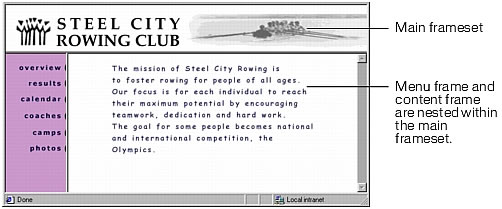Understanding nested framesets
Understanding nested framesets
A frameset inside another frameset is called a nested frameset. A single frameset file can contain multiple nested framesets. Most web pages that use frames are actually using nested frames, and most of the predefined framesets in Dreamweaver also use nesting. Any set of frames in which there are different numbers of frames in different rows or columns requires a nested frameset.
For example, the most common frame layout has one frame in the top row (where the company’s logo appears) and two frames in the bottom row (a navigation frame and a content frame). This layout requires a nested frameset: a two-row frameset, with a two-column frameset nested in the second row.

Dreamweaver takes care of nesting framesets as needed; if you use the frame-splitting tools in Dreamweaver, you don’t need to worry about the details of which frames are nested and which aren’t. For more information about the frame-splitting tools, see Designing a frameset.
There are two ways to nest framesets in HTML: the inner frameset can be defined either in the same file as the outer frameset, or in a separate file of its own. Each predefined frameset in Dreamweaver defines all of its framesets in the same file.
Both kinds of nesting produce the same visual results; it’s not easy to tell, without looking at the code, which kind of nesting is being used. The most likely situation in which an external frameset file would be used in Dreamweaver is when you use the Open in Frame command to open a frameset file inside a frame; doing this may result in problems with setting targets for links. It’s generally simplest to keep all framesets defined in a single file.
Related topics
- Understanding how frames and framesets work
- Deciding whether to use frames
 |  |





